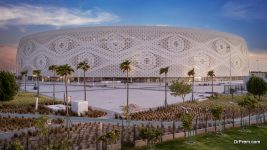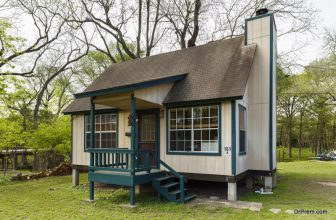
The Details on Qatar’s Sustainable Stadiums – Ecofriend.com
Strangely, we are just days away from the start of the 2022 World Cup, a tournament that should have played in summer.
FIFA’s decision to award the hosting rights to Qatar in 2010 has come under heavy criticism, with many alleging bribery and corruption were the sole reason for the tournament being awarded to the Gulf State instead of the United States.
Then came the scandal surrounding the stadiums with Amnesty International claiming that migrant labourers had been threatened, abused and forced to live in appalling conditions whilst building stadiums for the tournament.
On top of this, the host nation have been criticised for the environmental costs of their stadiums and the cooling systems needed to keep players and fans from overheating in the baking dessert heat.
In this article we take a look at some of the sustainability measures taken by the stadium designers to mitigate their harmful, environmental impact.
The Lusail Stadium
The venue for this year’s final, which judging by the latest World Cup Odds, could see France attempt to retain their crown on December 18th is also, according to FIFA the holder of a five-star sustainability rating.
The Global Sustainability Assessment System (GSAS), formerly known as the Qatar Sustainability Assessment System, awarded the Lusail Stadium five stars because of its roof, which is made from PTFE, a synthetic fluoropolymer which helps to keep the sizzling heat from the sun out along with sand and other detritus.
It is thought that this roof system will reduce the air conditioning burden at the stadium.
Al Bayt Stadium
This 60,000 seater stadium will play host the opening game of the tournament and one of the semi-finals. Following the conclusion of the World Cup, the capacity will be reduced to 32,000 with the 28,000 seats removed being donated to countries in need of sporting infrastructure.
In the official FIFA World Cup Qatar 2022 Sustainability brochure, the organisers claim that over 70% of the external lighting will be powered by solar energy. Whether that will offset the enormous amount of energy used to cool the stadium remains to be seen.
Al Janoub Stadium
The design for this stadium has led it to becoming the centre of a number of crude jokes on the internet. It is despite those barbs, one of the most visually stunning stadiums at the tournament.
Like Al Bayt, Al Janoub stadium will be reducing its capacity after the tournament from 40,000 to 20,000 and donating the seats to foreign countries. In addition to that, all the excess water used in the air conditioning will be repurposed for water saving in toilets.
Al Thumama Stadium
This 40,000 capacity stadium, which has been modelled on the traditional gahfiyacap will be the venue for a quarter-final game. Fans making their way to the stadium will feel their blood pressure falling and their minds relaxing as they walk through a landscape 80% covered with native vegetation.
Ras Abu Aboud Stadium
Located to a nearby port, this stadium has a quirky design that pays homage to the hundreds of thousands of shipping containers that pass through Qatari waters each year.
Originally it was mean to be called the 974 Stadium in reference to the exact number of shipping containers used as part of construction. From a sustainability point of view, it is perhaps the first truly genuine sustainable stadium on the planet.
After the tournament it will be dismantled, with the all of the recovered materials being donated to good causes. As part of the stadium’s design, its structure allows for a high level of natural ventilation which should, in theory, reduce the air conditioning costs.
Sustainability Facts
According to the organisers, the stadiums used at the tournament and their construction have had the following sustainability impacts:
- 850,000m² of Green Space: In a bid to cool down stadiums and fan walkways, designers have planted 850,000 m² of green space, the equivalent of 121 football pitches. This is made up on 16,000 trees and a number of plants which will all provide natural habitats for native birds and lizards.
- Waste Minimisation & Water Recycling: During the construction period, 90% of all the waste generated at Al Janoub and Al Rayyan was recycled or reused. This was in addition to the wastewater recycling scheme which saw the water used by workers recycled as flushable toilet water or for dust control.
- Public Transport: The size of Qatar has led to a number of logistical problems in terms of hosting hundreds of thousands of fans. One way in which organisers have navigated this is by investing heavily in public transport infrastructure. Sustainable methods of transport from bicycles to the metro system will be available to everyone.
Summary
The World Cup should never have been held in Qatar in the first place and the conditions endured by construction workers were abominable. Sustainability features in stadiums very much feels like a little far too late, but it is at least something.
Article Submitted By Community Writer
creditSource link







